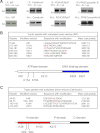Proteomic assessment shows that many endoplasmic reticulum (ER)-resident proteins are targeted by N(epsilon)-lysine acetylation in the lumen of the organelle and predicts broad biological impact
- PMID: 22628546
- PMCID: PMC3391156
- DOI: 10.1074/jbc.C112.362871
Proteomic assessment shows that many endoplasmic reticulum (ER)-resident proteins are targeted by N(epsilon)-lysine acetylation in the lumen of the organelle and predicts broad biological impact
Abstract
In addition to the nucleus, cytosol, and mitochondrial lumen, N(ε)-lysine acetylation also occurs in the lumen of the endoplasmic reticulum (ER). However, the impact of such an event on ER functions is still unknown. Here, we analyzed the "ER acetyl-lysine proteome" by nano-LC-MS/MS and discovered that a large number of ER-resident and -transiting proteins undergo N(ε)-lysine acetylation in the lumen of the organelle. The list of ER-resident proteins includes chaperones and enzymes involved with post-translational modification and folding. Grouping of all acetylated proteins into major functional categories suggests that the ER-based acetylation machinery regulates very diverse biological events. As such, it is predicted to play a fundamental role in human physiology as well as human pathology.
Figures



Similar articles
-
Lysine acetylation in the lumen of the ER: a novel and essential function under the control of the UPR.Biochim Biophys Acta. 2013 Mar;1833(3):686-97. doi: 10.1016/j.bbamcr.2012.12.004. Epub 2012 Dec 13. Biochim Biophys Acta. 2013. PMID: 23247107 Free PMC article. Review.
-
Intracellular Citrate/acetyl-CoA flux and endoplasmic reticulum acetylation: Connectivity is the answer.Mol Metab. 2023 Jan;67:101653. doi: 10.1016/j.molmet.2022.101653. Epub 2022 Dec 10. Mol Metab. 2023. PMID: 36513219 Free PMC article. Review.
-
Nε-lysine acetylation in the endoplasmic reticulum - a novel cellular mechanism that regulates proteostasis and autophagy.J Cell Sci. 2018 Nov 16;131(22):jcs221747. doi: 10.1242/jcs.221747. J Cell Sci. 2018. PMID: 30446507 Free PMC article. Review.
-
Acetyl-CoA flux regulates the proteome and acetyl-proteome to maintain intracellular metabolic crosstalk.Nat Commun. 2019 Sep 2;10(1):3929. doi: 10.1038/s41467-019-11945-9. Nat Commun. 2019. PMID: 31477734 Free PMC article.
-
Ca+2 and Nε-lysine acetylation regulate the CALR-ATG9A interaction in the lumen of the endoplasmic reticulum.Sci Rep. 2024 Oct 26;14(1):25532. doi: 10.1038/s41598-024-76854-4. Sci Rep. 2024. PMID: 39462136 Free PMC article.
Cited by
-
SLC13A5/sodium-citrate co-transporter overexpression causes disrupted white matter integrity and an autistic-like phenotype.Brain Commun. 2022 Jan 5;4(1):fcac002. doi: 10.1093/braincomms/fcac002. eCollection 2022 Feb. Brain Commun. 2022. PMID: 35146426 Free PMC article.
-
In Steatotic Cells, ATP-Citrate Lyase mRNA Is Efficiently Translated through a Cap-Independent Mechanism, Contributing to the Stimulation of De Novo Lipogenesis.Int J Mol Sci. 2020 Feb 11;21(4):1206. doi: 10.3390/ijms21041206. Int J Mol Sci. 2020. PMID: 32054087 Free PMC article.
-
Improved proteostasis in the secretory pathway rescues Alzheimer's disease in the mouse.Brain. 2016 Mar;139(Pt 3):937-52. doi: 10.1093/brain/awv385. Epub 2016 Jan 19. Brain. 2016. PMID: 26787453 Free PMC article.
-
Changes in Protein Expression and Lysine Acetylation Induced by Decreased Glutathione Levels in Astrocytes.Mol Cell Proteomics. 2016 Feb;15(2):493-505. doi: 10.1074/mcp.M115.049288. Epub 2015 Oct 20. Mol Cell Proteomics. 2016. PMID: 26486419 Free PMC article.
-
Coenzyme a Biochemistry: From Neurodevelopment to Neurodegeneration.Brain Sci. 2021 Aug 2;11(8):1031. doi: 10.3390/brainsci11081031. Brain Sci. 2021. PMID: 34439650 Free PMC article. Review.
References
-
- Yang X. J., Seto E. (2007) HATs and HDACs: from structure, function, and regulation to novel strategies for therapy and prevention. Oncogene 26, 5310–5318 - PubMed
Publication types
MeSH terms
Substances
Grants and funding
LinkOut - more resources
Full Text Sources
Research Materials

